Residual Stress Redistribution Analysis in the Repair Welding of AA6082-T6 Aluminum Alloy Joints: Experiment and Simulation
Abstract
:1. Introduction
2. Materials and Methods
2.1. Preparation of Test Specimens
2.2. Stress Linearization According to BS7910
3. Results and Discussion
3.1. Repair Welding Schemes
- (1)
- Repair welding length schemes
- (2)
- Repair welding depth schemes
- (3)
- Repair welding width schemes
- (1)
- Analysis of the longitudinal residual stress (LRS) and transverse residual stress (LRS) nephograms under different repair length, depth and width, as shown in Figure 3;
- (2)
- Analysis of the temperature variation at different positions of butt joints during the welding process;Analyze the temperature variation of three points at the longitudinal centerline on the upper surface of butt joints with time, as shown in Figure 3 (Point1: at WCL; Point2: at WT; Point3: at HAZ), and validate the accuracy of heat source models in FEA;
- (3)
- Analysis of longitudinal and transverse residual stress distribution at WCL and WT.According to the principle of stress linearization, the LRS and TRS distribution at WCL and WT under different repair lengths, depths, and widths was extracted and analyzed;
- (4)
- Analysis of membrane and bending stress distribution in the longitudinal and transverse directions at WCL and WT;
- (5)
- Analysis of the LRS and TRS distribution at the longitudinal centerline on the upper surface of butt plates (i.e., path 1);
- (6)
- According to the comprehensive analysis of simulation results, the optimal repair length, depth, and width were determined.
3.2. Finite Element Modeling for Repair Welding
- (1)
- As-welded FE modeling
- (2)
- Analysis steps
- (3)
- Repair welding modeling
3.3. Effects of Repair Welding Length
3.4. Effect of Repair Depth
3.5. Effect of Repair Width
4. Conclusions
- The residual stress results of FEA were in good agreement with the blind-hole drilling test, which validated the accuracy of the FE simulation;
- According to the stress linearization in BS7910, transverse membrane stress for repair welding length L1 (15t), depth D3 (0.75t), and width W3 (2t) became greater by 76.6%, 13.5%, and 40.5%, respectively, compared with that for repair welding length L3 (4t) depth D1 (0.25t) and width W1 (1t);
- The optimal repair welding length, depth, and width in this paper are 15t, 0.25t, and t, respectively, which conforms with the repair welding principle of “SNL (shallow, narrow, and long)” and which provides a significant guiding role for the repair welding of welded structures in actual production.
Author Contributions
Funding
Conflicts of Interest
References
- Su, K.; Zhang, J.; Zhang, Y.; Yan, T.; Li, H.; Ji, D. High-Cycle Fatigue Properties and Residual Stress Relaxation Mechanism of Micro-Arc Oxidation 6082-T6 Aluminum Alloy. Acta Metall. Sin. 2022, 58, 334–344. [Google Scholar]
- Hu, X.; Jiang, H.-Y.; Luo, Y.; Jin, Q.; Peng, W.; Yi, C. A Study on Microstructure, Residual Stresses and Stress Corrosion Cracking of Repair Welding on 304 Stainless Steel: Part II-Effects of Reinforcement Height. Materials 2020, 13, 2434. [Google Scholar] [CrossRef] [PubMed]
- Li, W.; Liang, Z.; Cai, C.; Wang, D. Repair Welding of the Tunnel Defect in Friction Stir Weld. High. Temp. Mat. Process. 2018, 37, 675–681. [Google Scholar] [CrossRef]
- Moreno, J.; Conde, F.; Correa, C.; Barbosa, L.; da Silva, E.; Avila, J.; Buzolin, R.; Pinto, H. Pulsed FCAW of Martensitic Stainless Clads onto Mild Steel: Microstructure, Hardness, and Residual Stresses. Materials 2022, 15, 2715. [Google Scholar] [CrossRef] [PubMed]
- Li, D.; Wang, X. The Effect of Plug Rotation Speed on Micro-Structure of Nugget Zone of Friction Plug Repair Welding Joint for 6082 Aluminum Alloy. Materials 2021, 14, 5287. [Google Scholar] [CrossRef] [PubMed]
- Seo, J.; Kwon, S.; Lee, C.; Lee, D.; Goo, B. Fatigue strength and residual stress evaluation of repair welding of bogie frame for railway vehicles. Eng. Fail. Anal. 2021, 119, 104980. [Google Scholar] [CrossRef]
- Kim, J.; Kim, M.; Yang, J. Investigation on effect of thermal aging embrittlement on residual stresses of austenitic stainless steel repair welds in nuclear components subject to seismic loads. J. Mech. Sci. Technol. 2020, 34, 2821–2831. [Google Scholar] [CrossRef]
- Moarrari, M.; Shokrieh, M.; Moshayedi, H. Effects of residual stresses induced by repair welding on the fracture toughness of Ni-based IN939 alloy. Theor. Appl. Fract. Mech. 2020, 108, 102614. [Google Scholar] [CrossRef]
- Voropaev, A.; Protsenko, V.; Anufriyev, D.; Kuznetsov, M.; Mukhin, A.; Sviridenko, M.; Kuryntsev, S. Influence of Laser Beam Wobbling Parameters on Microstructure and Properties of 316L Stainless Steel Multi Passed Repaired Parts. Materials 2022, 15, 722. [Google Scholar] [CrossRef]
- Luo, Y.; Gu, W.; Peng, W.; Jin, Q.; Qin, Q.; Yi, C. A Study on Microstructure, Residual Stresses and Stress Corrosion Cracking of Repair Welding on 304 Stainless Steel: Part I-Effects of Heat Input. Materials 2020, 13, 2416. [Google Scholar] [CrossRef]
- Moattari, M.; Shokrieh, M.; Moshayedi, H. Evaluations of residual stresses in repair welding of Ni-based IN939 superalloy. J. Therm. Stresses 2020, 43, 801–815. [Google Scholar] [CrossRef]
- Kang, M.; Jiang, M.; Sridar, S.; Xiong, W.; Xie, Z.; Wang, J. Effect of Multiple Repair Welding on Crack Susceptibility and Mechanical Properties of Inconel 718 Alloy Casting. J. Mater. Eng. Perform. 2022, 31, 254–261. [Google Scholar] [CrossRef]
- Zhang, H.; Liu, X.; Liu, H.; Mei, R.; Chen, X. Interfacial Feature and Mechanical Property of Friction Stir Lap Repair Welded 7B04 Aluminum Alloy. J. Mater. Eng. Perform. 2020, 29, 6890–6897. [Google Scholar] [CrossRef]
- Marenych, O.; Kostryzhev, A.; Pan, Z.; Li, H.; Duin, V. Application of wire arc additive manufacturing for repair of Monel alloy components. Aust. J. Mech. Eng. 2021, 19, 609–617. [Google Scholar] [CrossRef]
- Amadeus, B.; Dirk, S.; Arne, K.; Thomas, K. Determination of residual stress evolution during repair welding of high-strength steel components. Forces Mech. 2022, 6, 100073. [Google Scholar] [CrossRef]
- Liu, C.; Wang, C.; Cheng, X.; Yan, Y.; Yang, J.; Guo, Y. Experimental Investigation on the Residual Stresses in a Thick Joint with a Partial Repair Weld Using Multiple-Cut Contour Method. Materials 2018, 11, 633. [Google Scholar] [CrossRef]
- Luo, Y.; Jiang, W.; Chen, D.; Wimpory, R.C.; Li, M.; Liu, X. Determination of Repair Weld Residual Stress in a Tube to Tube-Sheet Joint by Neutron Diffraction and the Finite Element Method. J. Press. Vessel Technol. 2018, 140, 021404. [Google Scholar] [CrossRef]
- Chatzidakis, S.; Tang, W.; Miller, R.; Payzant, A. Neutron diffraction illustrates residual stress behavior of welded alloys used as radioactive confinement boundary. Int. J. Press. Vessel Pip. 2021, 191, 104348. [Google Scholar] [CrossRef]
- Sarmast, A.; Schubnell, J.; Farajian, M. Finite element simulation of multi-layer repair welding and experimental investigation of the residual stress fields in steel welded components. Weld World 2022, 66, 1275–1290. [Google Scholar] [CrossRef]
- Ma, W.; Bai, T.; Li, Y.; Zhang, H.; Zhu, W. Research on Improving the Accuracy of Welding Residual Stress of Deep-Sea Pipeline Steel by Blind Hole Method. J. Mar. Sci. Eng. 2022, 10, 791. [Google Scholar] [CrossRef]
- He, J.; Wei, M.; Zhang, L.; Ren, C.; Wang, J.; Wang, Y.; Qi, W. Effect of Preheat Temperature and Welding Sequence on the Temperature Distribution and Residual Stress in the Weld Overlay Repair of Hydroturbine Runner. Materials 2022, 15, 4867. [Google Scholar] [CrossRef] [PubMed]
- Salerno, G.; Bennett, C.; Sun, W.; Becher, A.; Palumbo, N.; Kelleher, J.; Zhang, S. On the interaction between welding residual stresses: A numerical and experimental investigation. Int. J. Mech. Sci. 2018, 144, 654–667. [Google Scholar] [CrossRef]
- Xu, G.; Guo, Q.; Hu, Q.; Pan, H.; Qian, H.; Du, B. Numerical and Experimental Analysis of Dissimilar Repair Welding Residual Stress in P91 Steel Considering Solid-State Phase Transformation. J. Mater. Eng. Perform. 2019, 28, 5734–5748. [Google Scholar] [CrossRef]
- Zhang, H.; Han, T.; Wang, Y.; Wu, Q. Effects of Fillet Weld Size and Sleeve Material Strength on the Residual Stress Distribution and Structural Safety While Implementing the New Sleeve Repair Process. Materials 2021, 14, 7463. [Google Scholar] [CrossRef]
- Xiao, X.; Liu, Q.; Hu, M.; Li, K.; Cai, Z. Effect of Welding Sequence and the Transverse Geometry of the Weld Overlay on the Distribution of Residual Stress in the Weld Overlay Repair of T23 Tubes. Metals 2021, 11, 568. [Google Scholar] [CrossRef]
- Jiang, W.; Luo, Y.; Zeng, Q.; Wang, J.; Tu, S. Residual stresses evolution during strip clad welding, post welding heat treatment and repair welding for a large pressure vessel. Int. J. Press. Vessel Pip. 2021, 189, 104259. [Google Scholar] [CrossRef]
- Huang, T.; Jin, L.; Chen, T.; Qiu, Z. Development and evaluation of welding repair for threaded hole of Reactor Pressure Vessel flange. Int. J. Pres. Ves. Pip. 2021, 191, 104341. [Google Scholar] [CrossRef]
- Amirian, A.; Moussavi Torshizi, S.; Moradi Mayen Bolagh, M. Experimental Study of the Effects of Welding Depth and Heat Treatment on Residual Stresses in a Cracked Rotor. J. Fail. Anal. Prev. 2020, 20, 689–700. [Google Scholar] [CrossRef]
- Zhang, Y.; Yang, K.; Zhao, J. Experimental Research and Numerical Simulation of Weld Repair with High Energy Spark Deposition Method. Metals 2020, 10, 980. [Google Scholar] [CrossRef]
- Chu, Q.; Kong, X.; Tan, W. Introducing Compressive Residual Stresses into a Stainless-Steel T-Pipe Joint by an Overlay Weld. Metals 2021, 11, 1109. [Google Scholar] [CrossRef]
- Hasheemzadeh, M.; Garbatov, Y.; Soares, C. Welding-induced residual stresses and distortions of butt-welded corroded and intact plates. Mar. Struct. 2021, 79, 103041. [Google Scholar] [CrossRef]
- Charkhi, M.; Akbari, D. Experimental and numerical investigation of the effects of the pre-heating in the modification of residual stresses in the repair welding process. Int. J. Press. Vessel Pip. 2019, 171, 79–91. [Google Scholar] [CrossRef]
- Aung, M.; Kastuda, H.; Hirohata, M. Fatigue-performance improvement of patch-plate welding via PWHT with induction heating. J. Constr. Steel Res. 2019, 160, 280–288. [Google Scholar] [CrossRef]
- Dai, P.; Wang, Y.; Li, S.; Lu, S.; Feng, G.; Deng, D. FEM analysis of residual stress induced by repair welding in SUS304 stainless steel pipe butt-welded joint. J. Manuf. Process. 2020, 58, 975–983. [Google Scholar] [CrossRef]
- Chen, Z.; Wang, P.; Wang, H.; Xiong, Z. Thermo-mechanical analysis of the repair welding residual stress of AISI 316L pipeline for ECA. Int. J. Press. Vessel Pip. 2018, 194, 104469. [Google Scholar] [CrossRef]
- Jiang, W.; Luo, Y.; Wang, B.; Woo, W.; Tu, S. Neutron Diffraction Measurement and Numerical Simulation to Study the Effect of Repair Depth on Residual Stress in 316L Stainless Steel Repair Weld. J. Press. Vessel Technol. 2015, 137, 041406. [Google Scholar] [CrossRef]
- BS 7910: 2013+ A1; 2015 Guide to Methods for Assessing the Acceptability of Flaws in Metallic Structures. The British Standard Institution: London, UK, 2015.
- Garcia, M.; Cicero, S.; Gutierrez, O. Methodology for the Structural integrity assessment of the “Constitucion de 1812” Bridge, over the Bay of Cadiz (Cadiz, Spain). Procedia Struct. Integr. 2019, 22, 313–321. [Google Scholar] [CrossRef]
- Chen, Z.; Yu, B.; Wang, P.; Qian, H.; Dong, P. Fatigue behaviors of aluminum alloy butt joints with backing plates: Experimental testing and traction stress modeling. Int. J. Fatigue 2022, 163, 107040. [Google Scholar] [CrossRef]
- Yu, Z.; Ren, F.; Ma, H.; Zhang, A. Experimental study and numerical analysis on bearing capacity of 6082-T6 aluminum alloy columns under eccentric compression at elevated temperatures. Structures 2022, 35, 1219–1231. [Google Scholar] [CrossRef]

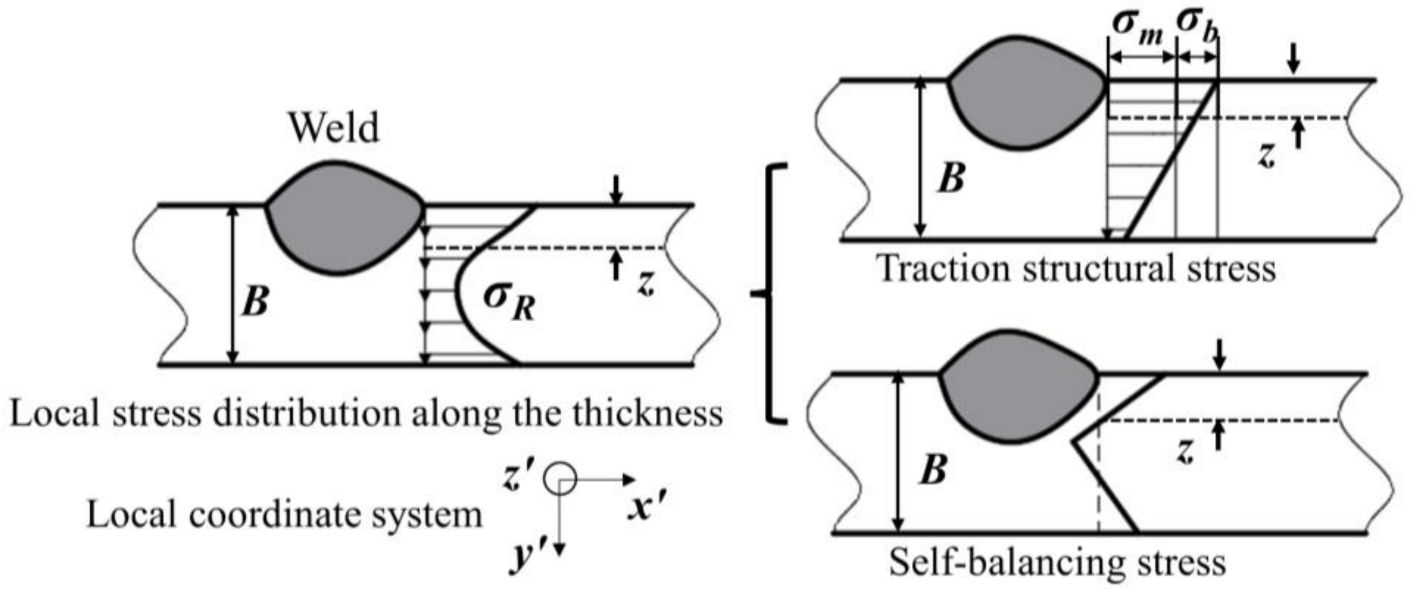
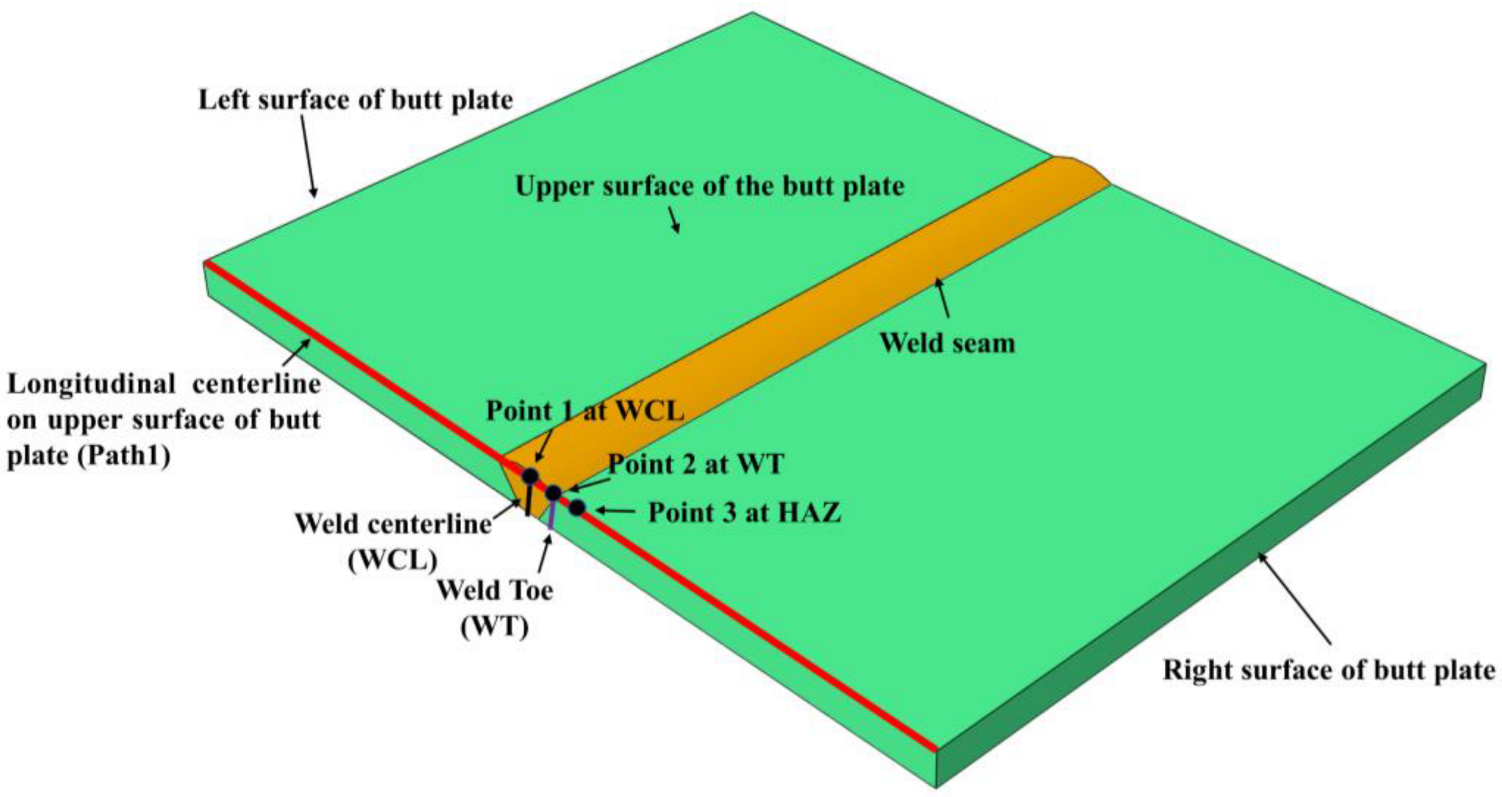



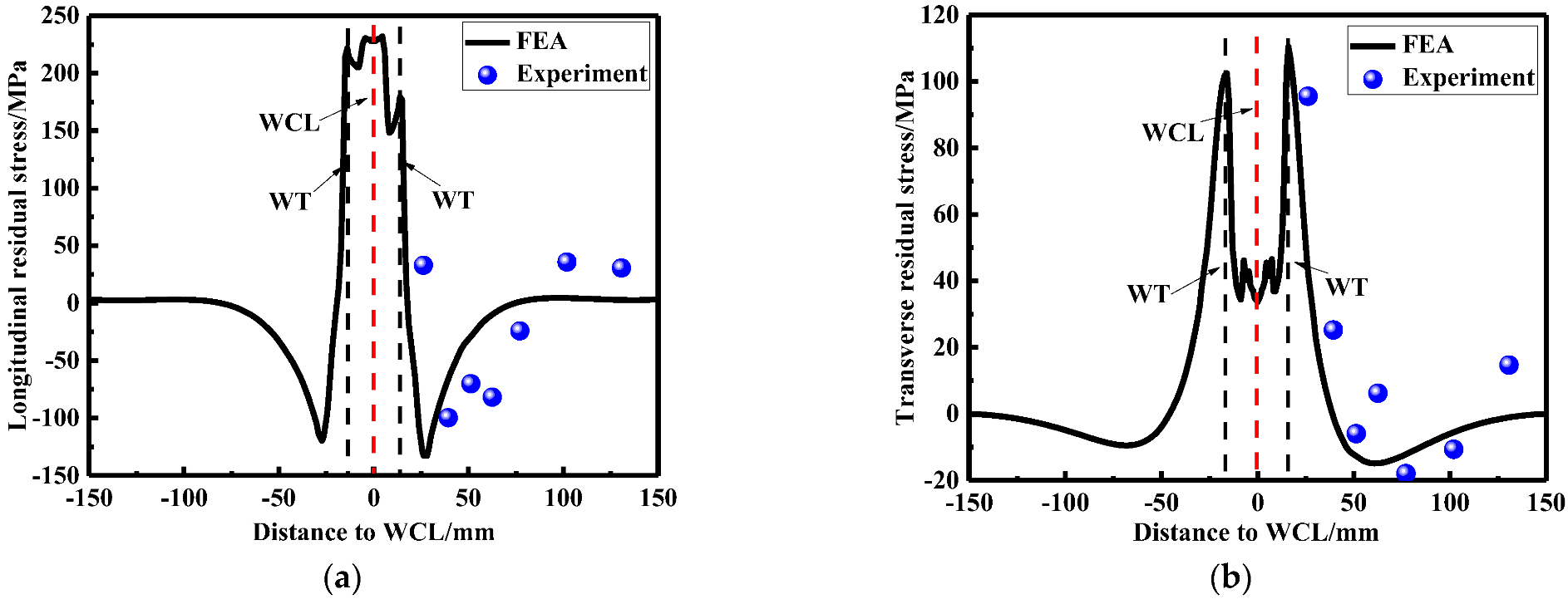

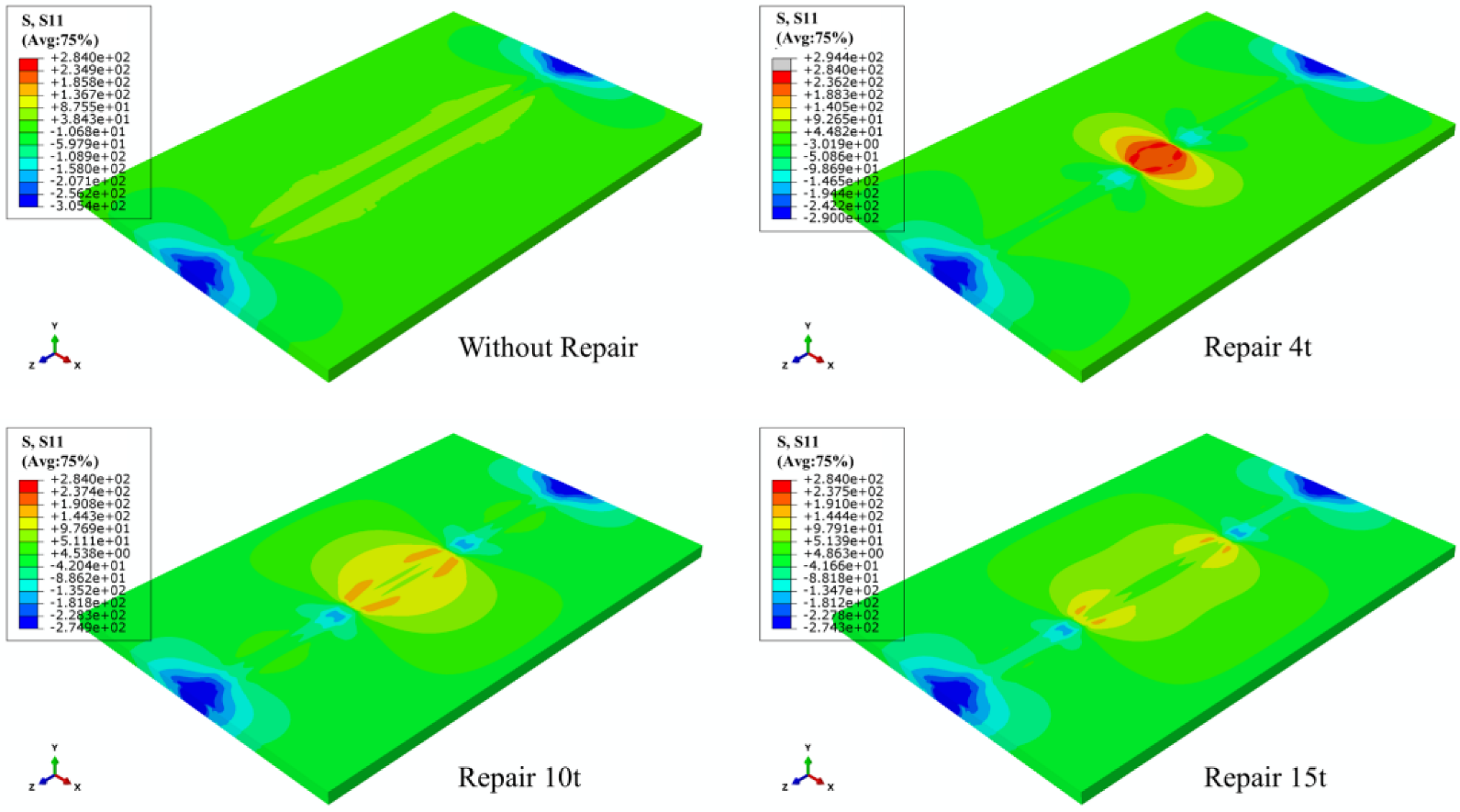

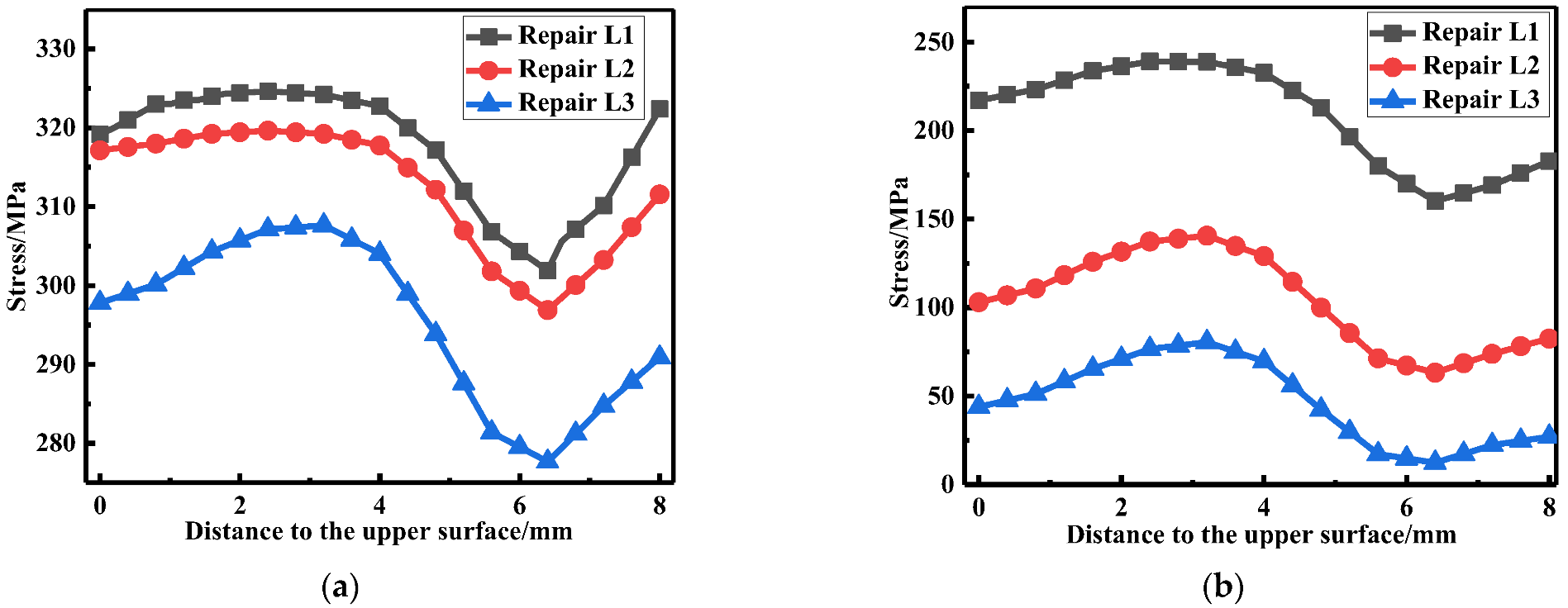
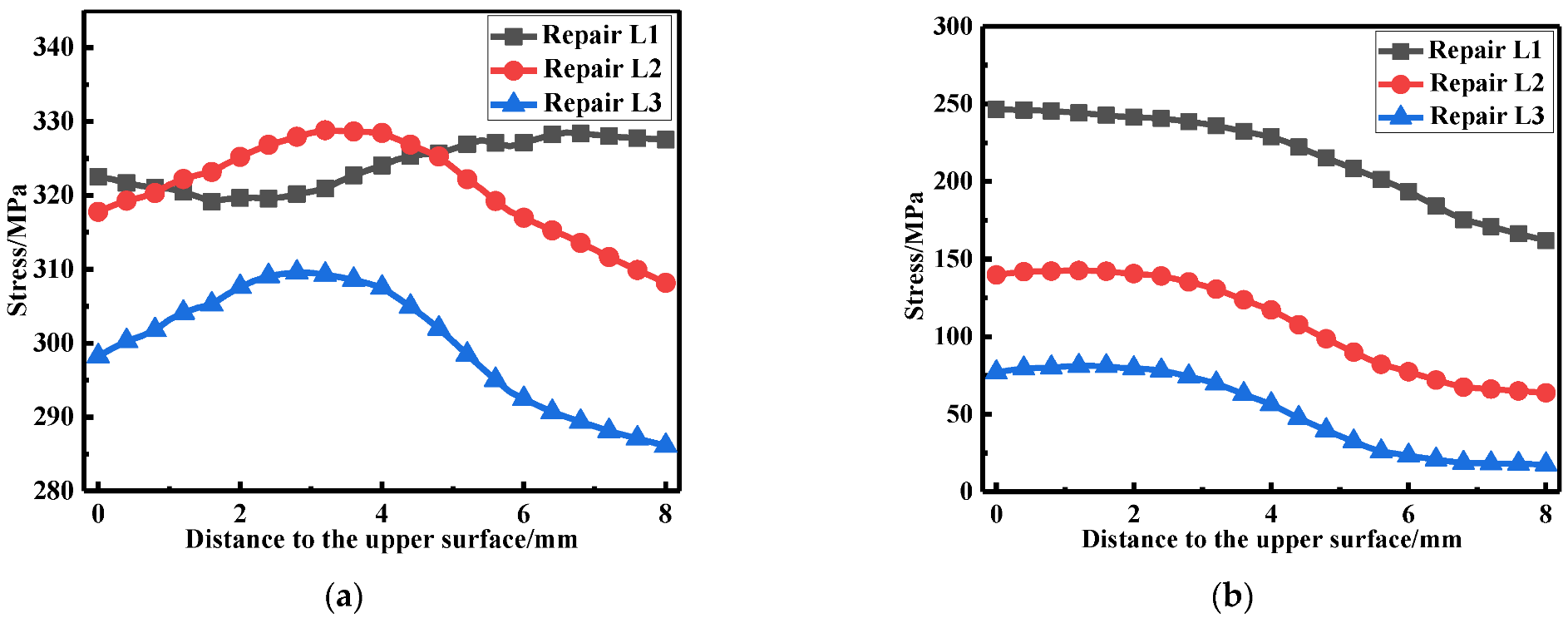


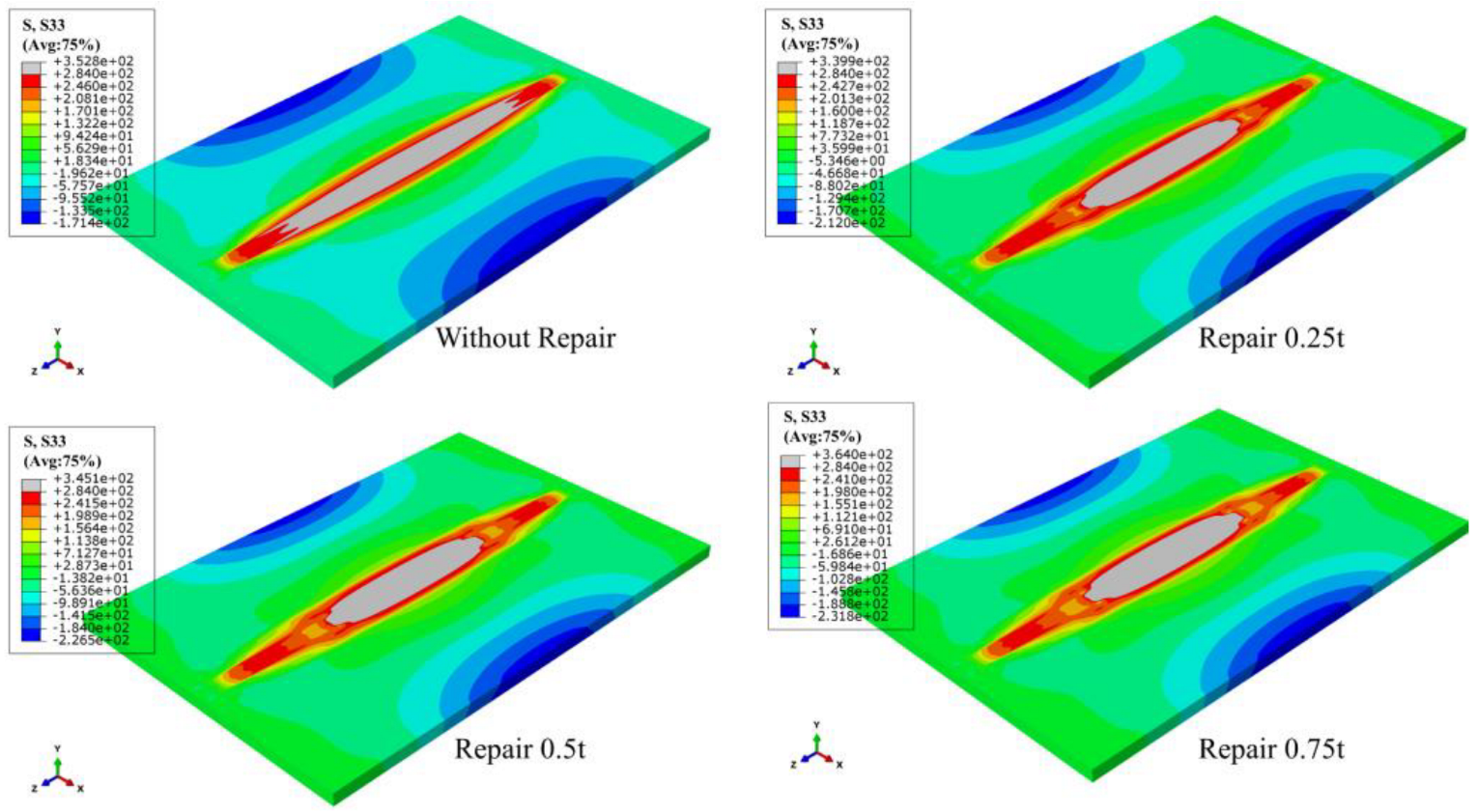



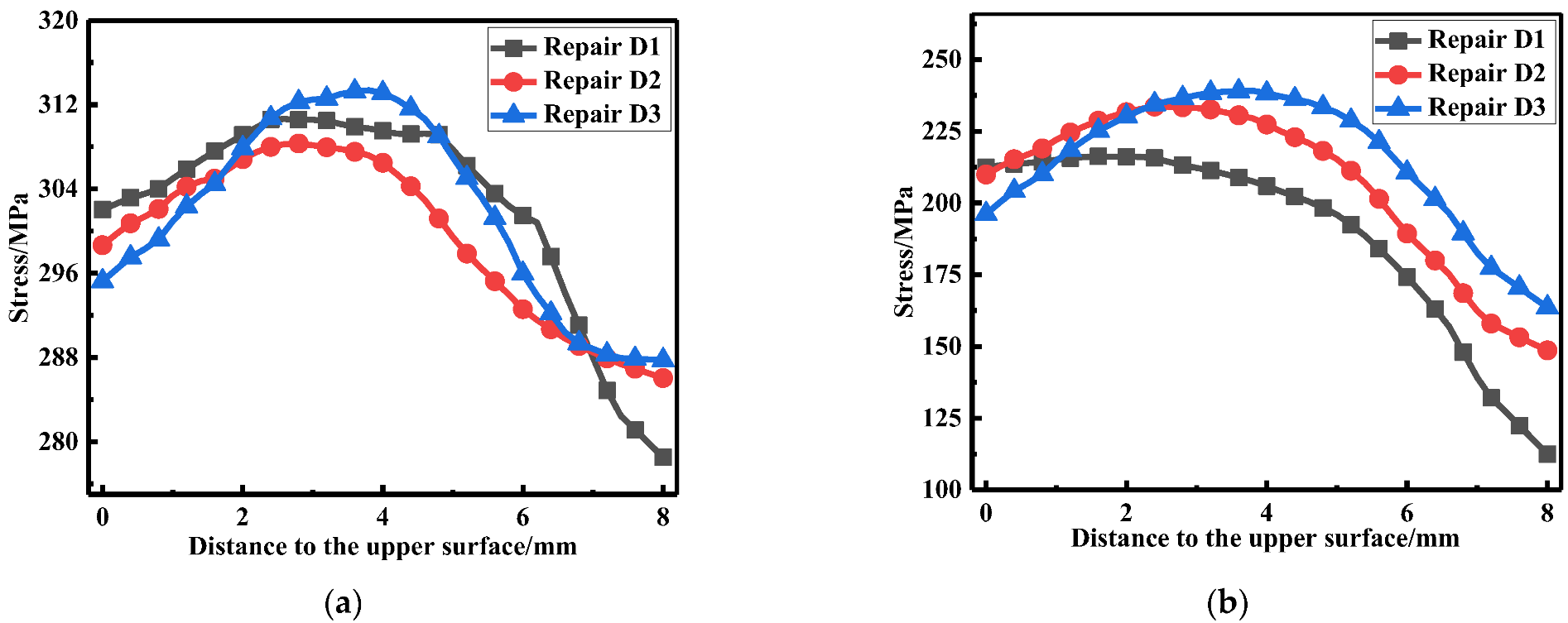

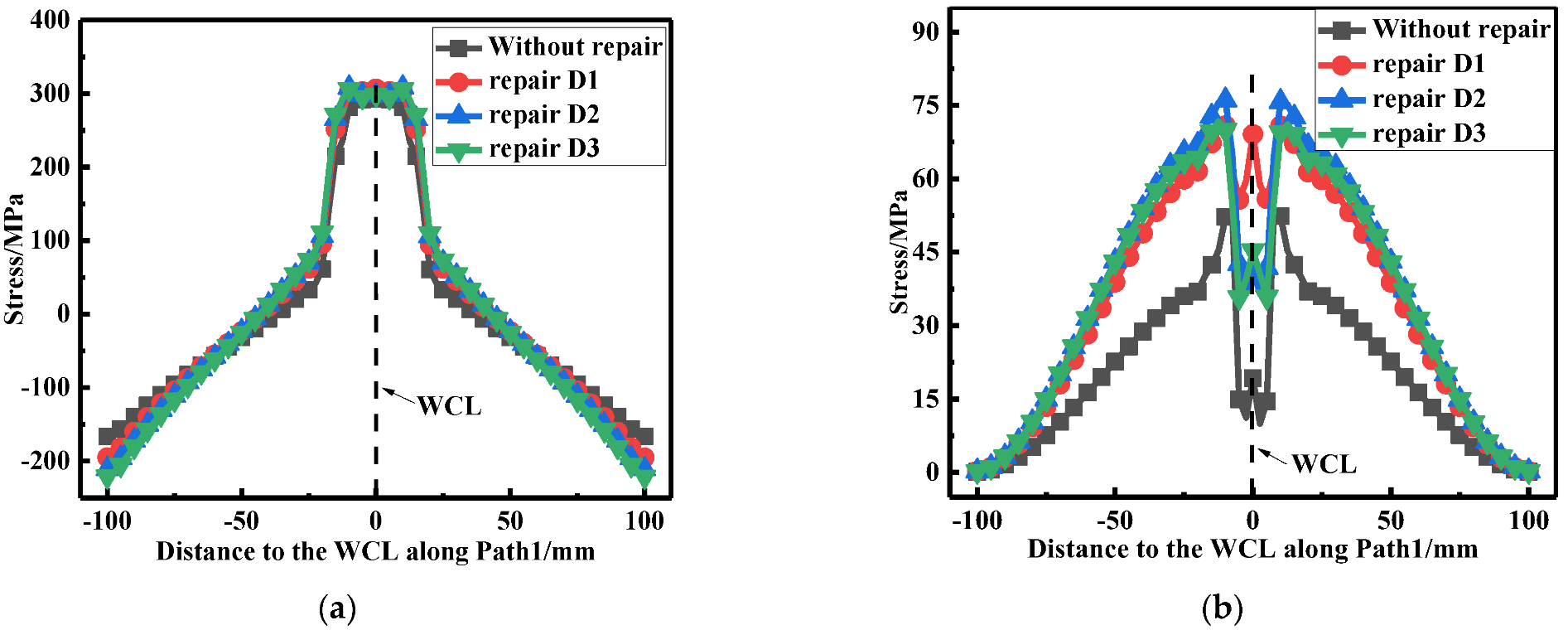
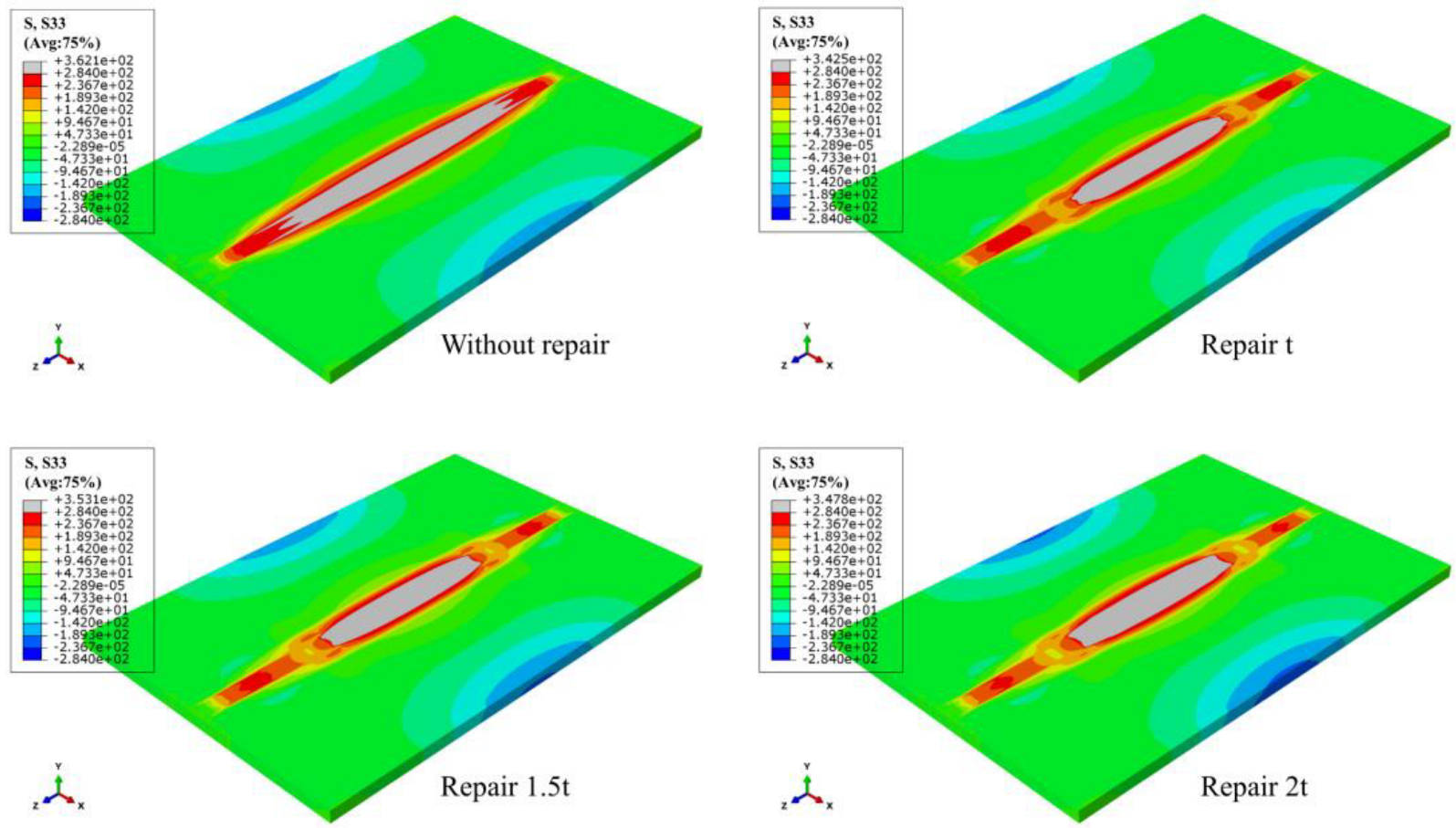
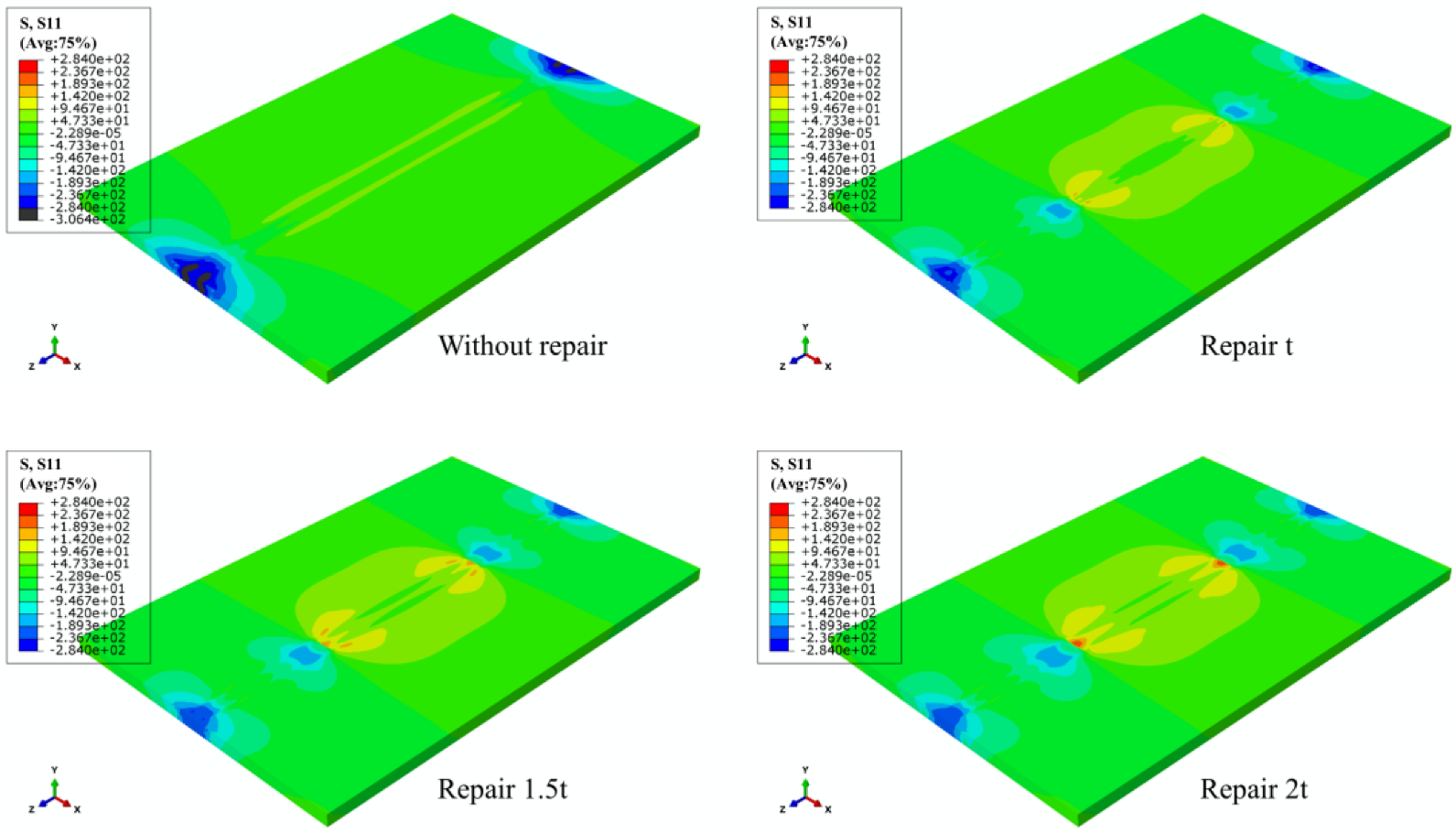

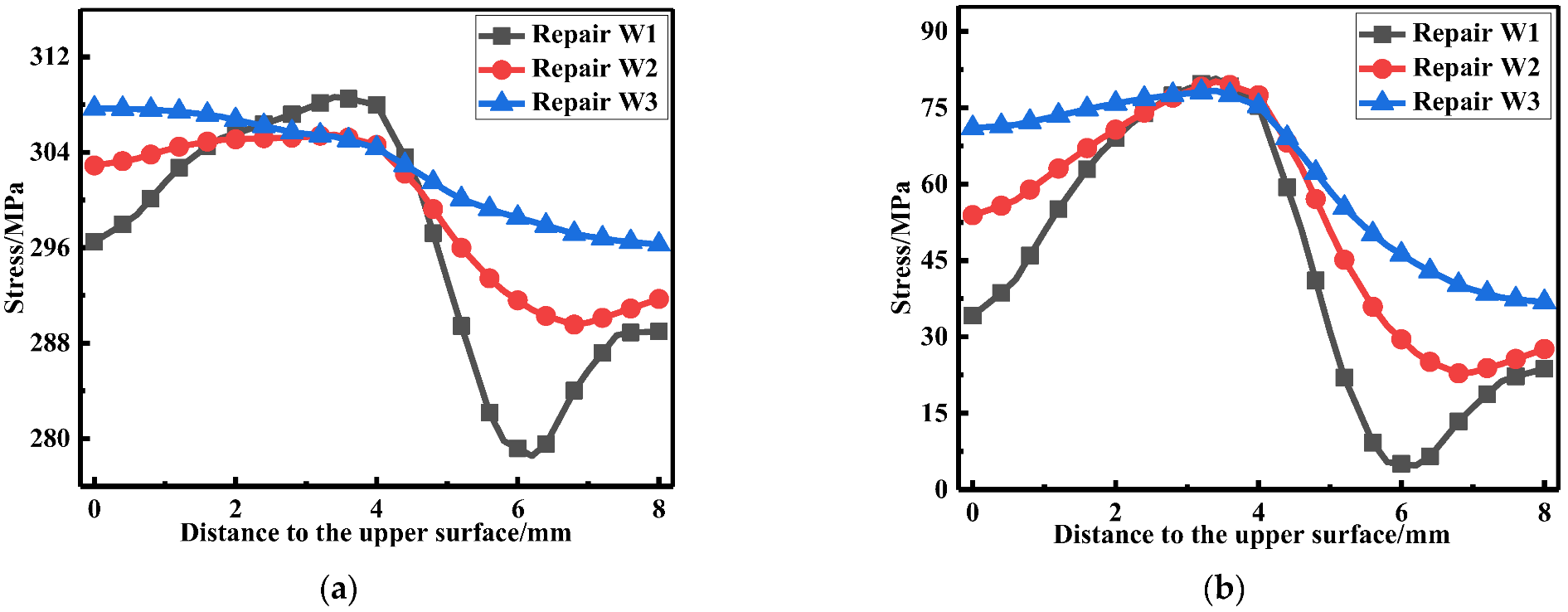

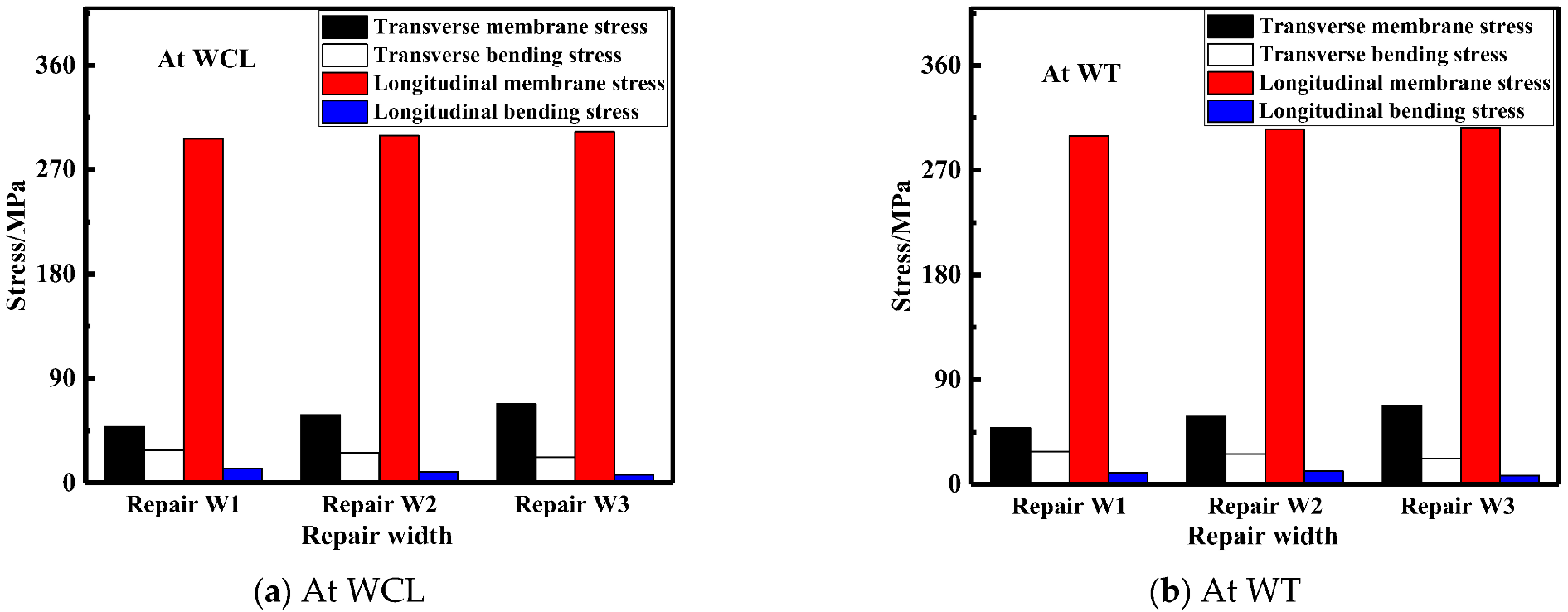
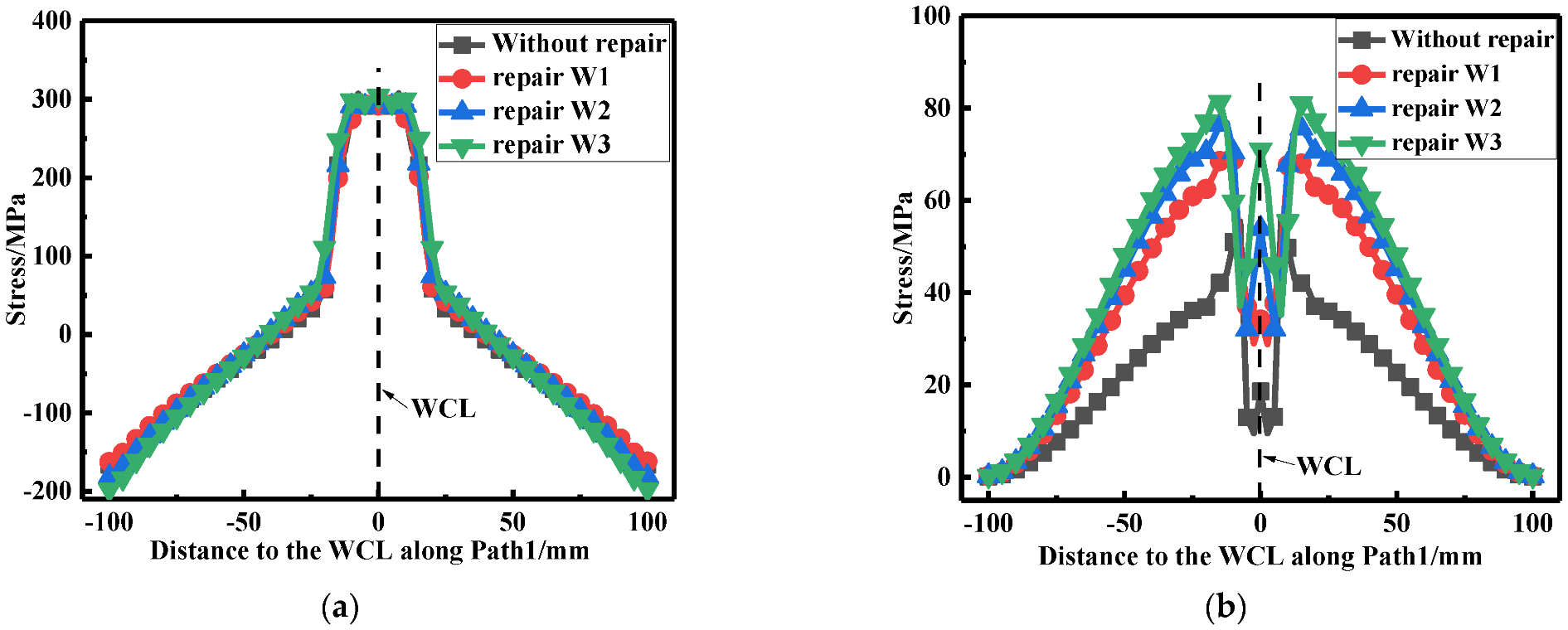
| Materials | Si | Fe | Cu | Mn | Mg | Cr | Zn | Ti | Al |
|---|---|---|---|---|---|---|---|---|---|
| AA6082-T6 | 1.30 | 0.50 | 0.10 | 1.20 | 1.20 | 0.15 | 0.20 | 0.20 | Bal. |
| ER5356 | 0.25 | - | 0.27 | 0.05 | 4.50 | - | - | - | Bal. |
| Properties | Yield Strength Rel/MPa | Tensile Strength Rm/MPa | Elongation e/% |
|---|---|---|---|
| AA6082-T6 | 275 | 280 | 9 |
| ER5356 | 120–190 | 250–300 | 15–25 |
| Plate Thickness t | Repair Width | Repair Depth | Repair Length L1 | Repair Length L2 | Repair Length L3 |
|---|---|---|---|---|---|
| 8 mm | t | t/2 | 4t | 10t | 15t |
| Plate Thickness t | Repair Width | Repair Length | Repair Depth D1 | Repair Depth D2 | Repair Depth D3 |
|---|---|---|---|---|---|
| 8 mm | t | 15t | 0.25t | 0.5t | 0.75t |
| Plate Thickness t | Repair Depth | Repair Length | Repair Width W1 | Repair Width W2 | Repair Width W3 |
|---|---|---|---|---|---|
| 8 mm | t/2 | 15t | t | 1.5t | 2t |
| Melting Temperature T1/°C | Heating Time t1/s | Room Temperature T2/°C |
|---|---|---|
| 660 | 3 | 20 |
| Surface thermal radiation coefficient | Heat transfer coefficient | Weld metal cooling time t2/s |
| 0.85 | 0.025 | 1500 |
Publisher’s Note: MDPI stays neutral with regard to jurisdictional claims in published maps and institutional affiliations. |
© 2022 by the authors. Licensee MDPI, Basel, Switzerland. This article is an open access article distributed under the terms and conditions of the Creative Commons Attribution (CC BY) license (https://creativecommons.org/licenses/by/4.0/).
Share and Cite
Chen, Z.; Duan, Y.; Wang, P.; Qian, H. Residual Stress Redistribution Analysis in the Repair Welding of AA6082-T6 Aluminum Alloy Joints: Experiment and Simulation. Materials 2022, 15, 6399. https://doi.org/10.3390/ma15186399
Chen Z, Duan Y, Wang P, Qian H. Residual Stress Redistribution Analysis in the Repair Welding of AA6082-T6 Aluminum Alloy Joints: Experiment and Simulation. Materials. 2022; 15(18):6399. https://doi.org/10.3390/ma15186399
Chicago/Turabian StyleChen, Zhihao, Yanjuan Duan, Ping Wang, and Hongliang Qian. 2022. "Residual Stress Redistribution Analysis in the Repair Welding of AA6082-T6 Aluminum Alloy Joints: Experiment and Simulation" Materials 15, no. 18: 6399. https://doi.org/10.3390/ma15186399





